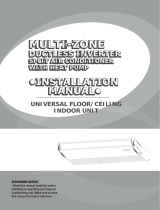
1
owner’s manual
1. IMPORTANT SAFETY INFORMATION
To prevent injury to the user or other people and property
damage, the following instructions must be followed. Incorrect
operation due to ignoring of instructions may cause harm or
damage.
Ask your dealer for installation of the air conditioner.
Incomplete installation performed by yourself may result in a
water leakage, electric shock, and fire.
Ask your dealer for improvement, repair, and
maintenance.
Incomplete improvement, repair, and maintenance may result
in a water leakage, electric shock, and fire.
In order to avoid electric shock, fire or injury, or if you
detect any abnormality such as smell of fire, turn off the
power supply and call your dealer for instructions.
Never let the indoor unit or the remote controller get wet.
It may cause an electric shock or a fire.
Never press the button of the remote controller with a
hard, pointed object.
The remote controller may be damaged.
Never replace a fuse with that of wrong rated current or
other wires when a fuse blows out.
Use of wire or copper wire may cause the unit to break down
or cause a fire.
It is not good for your health to expose your body to the
air flow for a long time.
Do not insert fingers, rods or other objects into the air
inlet or outlet.
When the fan is rotating at high speed, it will cause injury.
Never use a flammable spray such as hair spray, lacquer
or paint near the unit.
It may cause a fire.
Never touch the air outlet or the horizontal blades while
the swing flap is in operation.
Fingers may become caught or the unit may break down.
Never put any objects into the air inlet or outlet.
Objects touching the fan at high speed can be dangerous.
Never inspect or service the unit by yourself.
Ask a qualified service person to perform this work.
Do not dispose this product as unsorted municipal
waste. Collection of such waste separately for special
treatment is necessary.
Do not dispose of electrical appliances as unsorted
municipal waste, use separate collection facilities.
Contact you local government for information regarding the
connection systems available.
If electrical appliances are disposed of in landfills or
dumps, hazardous substances can leak into the
groundeater and get into the food chain, damaging your
health and well-being.
To prevent refrigerant leak, contact your dealer.
When the system is installed and runs in a small room, it is
required to keep the concentration of the refrigerant, if by any
chance coming out, below the limit. Otherwise, oxygen in the
room may be affected, resulting in a serious accident.
The refrigerant in the air conditioner is safe and normally
does not leak.
If the refrigerant leaks in the room, contact with a fire of a
burner, a heater or a cooker may result in a harmful gas.
Turn off any combustible heating devices, ventilate the
room, and contact the dealer where you purchased the
unit.
Do not use the air conditioner until a service person confirms
that the portion where the refrigerant leaks is repaired.
Do not use the air conditioner for other purposes.
In order to avoid any quality deterioration, do not use the unit
for cooling precision instruments, food, plants, animals or
works of art.
Before cleaning, be sure to stop the operation, turn the
breaker off or pull out the supply cord.
Otherwise, an electric shock and injury may result.
W ARNING
The safety precautions listed are divided into two categories. In either
case, important safety information is listed which must be read.
CAUTION
Failure to observe a caution may result in injury or damage
to the equipment.
Failure to observe a warning may result in death. The
appliance shall be installed in accordance with national
wiring regulations.
CONTENTS PAGE
IMPORTANT SAFETY INFORMATION..........................................................1
PARTS NAMES..........................................................................................2
AIR CONDITIONER OPERATIONS AND PERFORMANCE
.......................
....
...
5
ADJUSTING AIR FLOW DIRECTION............................................................6
MAINTENANCE................
........................
.
.........................
...................
....
10
FOLLOWING SYMPTOMS ARE NOT AIR CONDITIONER TROUBLES
........
.13
TROUBLESHOOTING................................................................................14
WARNING
CAUTION


















